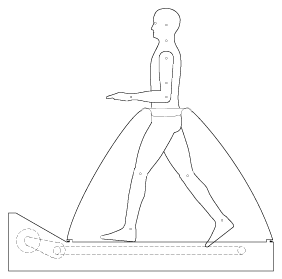1996 Project Reports | Home |
Contents | Previous |
Next |
Differential Pressure Walking Assist - an inflatable walking support
Charles Burgar, MD; Douglas Schwandt, MS; James Anderson, JEM; Robert
Whalen, PhD; Gregory Breit, PhD
Need - The Differential Pressure Walking Assist (DPWA), which
comfortably reduces the ground reaction force and lower limb muscle and joint
forces, is intended for patients recovering from neurologic diseases and
orthopedic procedures.
Concept - The lower body differential pressure concept was invented
at the Life Science Division of NASA-Ames Research Center to investigate space
exercise applications, and to simulate hypo- and hyper-gravity effects on
biomechanics and cardiovascular physiology.
The DPWA consists of an inflatable vinyl skirt with a flexible, air-tight
neoprene waist seal enclosing the subject' lower body. The skirt is attached to
a wooden treadmill enclosure. A lifting force equal to the pressure difference
times the waist cross-sectional area supports the subject during ambulation,
removing half of the subject's effective weight with 1 psi (50 mmHg)
differential pressure. Since the upper and lower body air pressures are
uniformly distributed over the body surfaces, the subject simply feels lighter,
similar to being buoyed up by waist-deep water. The lifting force can easily be
controlled by adjusting chamber pressure to adapt to an individual patient's
needs as he or she progresses through rehabilitation
 Figure 1. The
inflatable walking support provides controlled reduction of patient effective
weight.
Work Accomplished - During an initial study to investigate
cardiovascular effects on able-bodied subjects during standing, buoyant forces
up to 100% of body weight were demonstrated without adverse cardiovascular
effects (the changes in heart rate and mean arterial blood pressure did not
differ significantly from those experienced when moving from supine to
standing). An improved system has been completed that incorporates a
transparent vinyl enclosure supported by netting. A zipper has been added to
facilitate entry and exit of the device for patients with limited mobility.
|
Future Plans - We will confirm the safety of the DPWA for subjects
with cardiovascular disease common in the older patient population the DPWA is
intended to serve. Additional studies will focus on the efficacy of the DPWA in
treating specific neuromuscular and orthopedic conditions. If results continue
to be encouraging, a commercial version of the device will be developed in
collaboration with an industrial partner.
Republished from the 1996 Rehabilitation R&D Center Progress Report. For
current information about this project, contact:
Charles Burgar.

